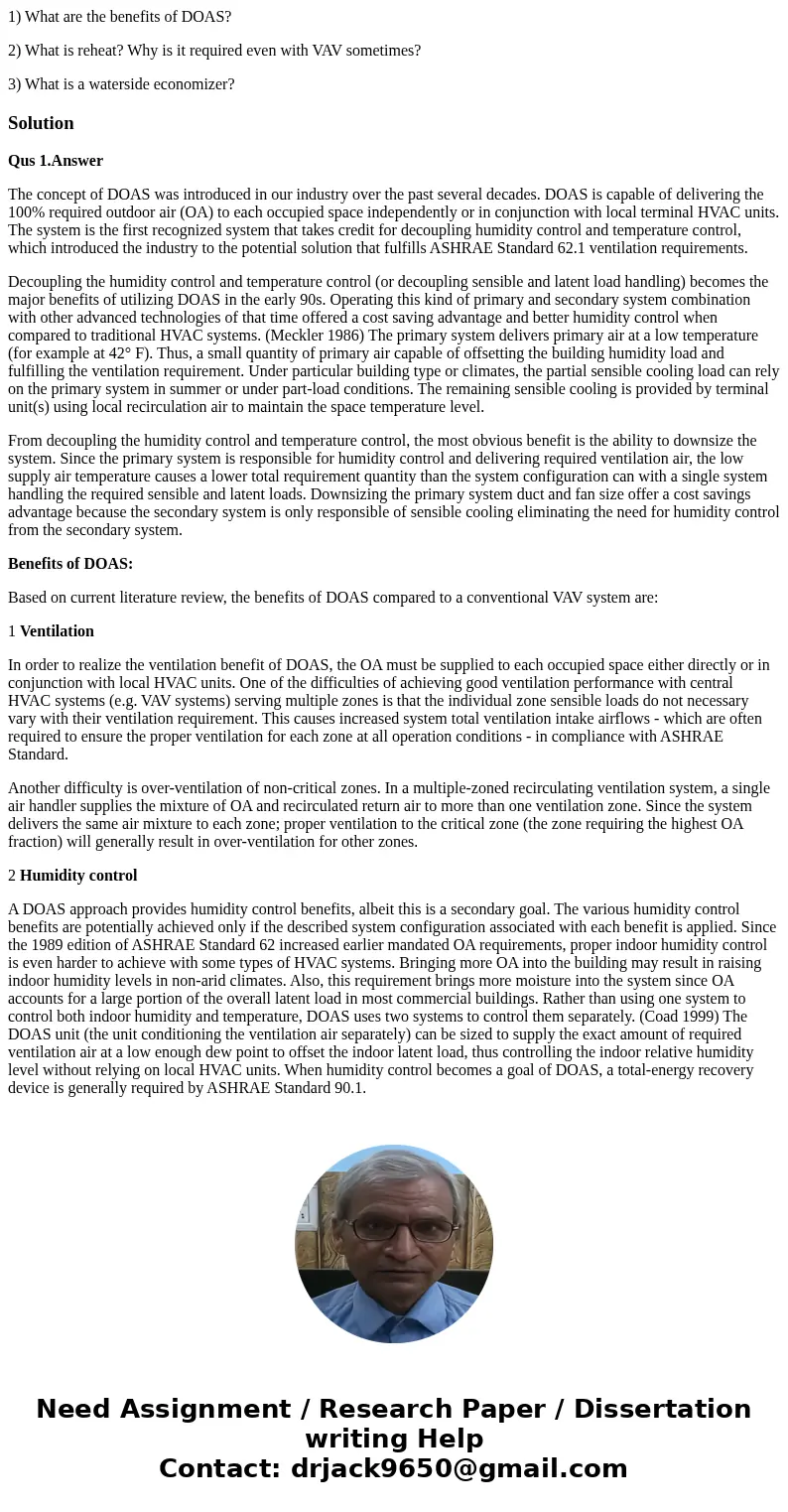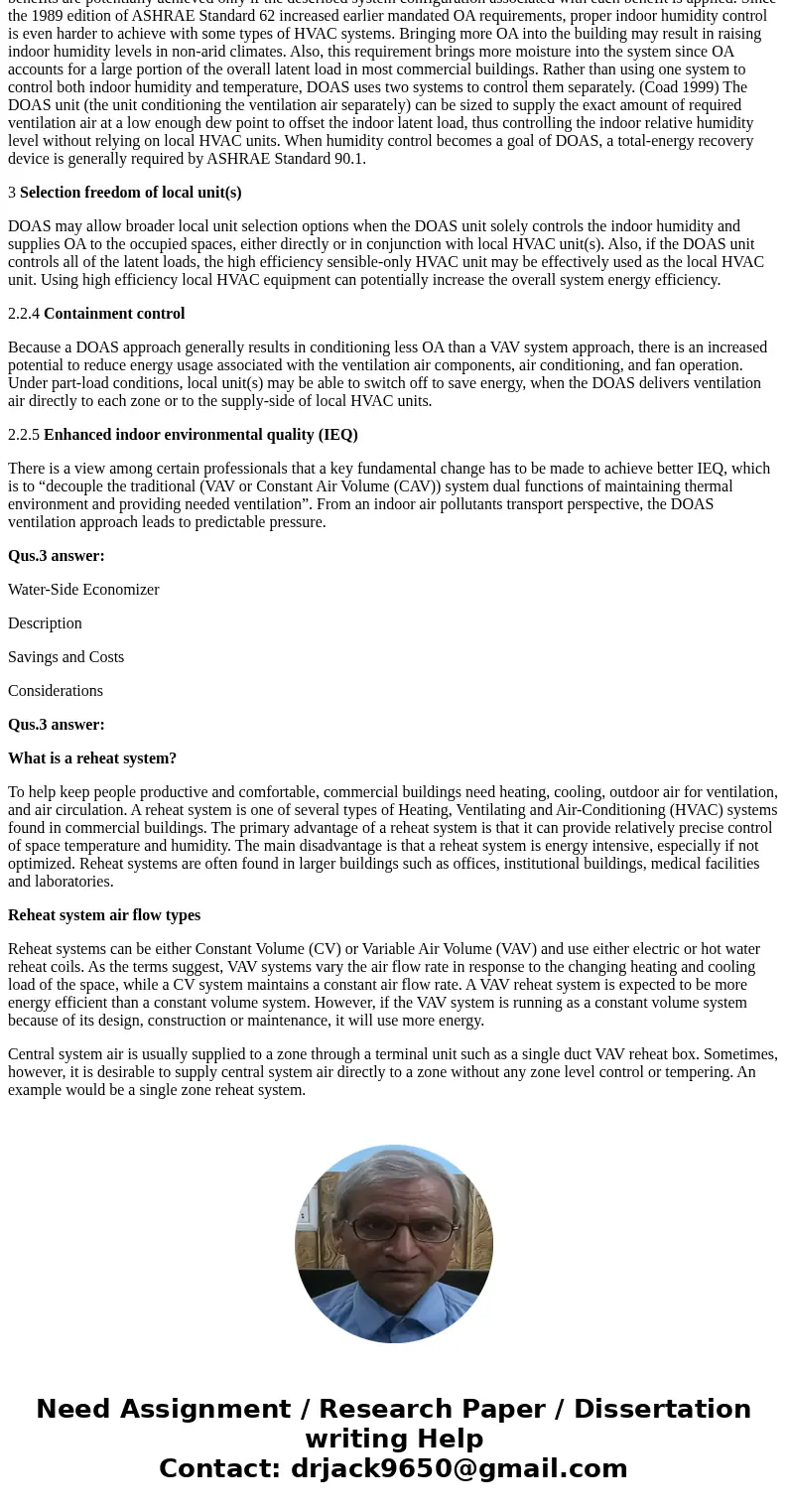1 What are the benefits of DOAS 2 What is reheat Why is it r
1) What are the benefits of DOAS?
2) What is reheat? Why is it required even with VAV sometimes?
3) What is a waterside economizer?
Solution
Qus 1.Answer
The concept of DOAS was introduced in our industry over the past several decades. DOAS is capable of delivering the 100% required outdoor air (OA) to each occupied space independently or in conjunction with local terminal HVAC units. The system is the first recognized system that takes credit for decoupling humidity control and temperature control, which introduced the industry to the potential solution that fulfills ASHRAE Standard 62.1 ventilation requirements.
Decoupling the humidity control and temperature control (or decoupling sensible and latent load handling) becomes the major benefits of utilizing DOAS in the early 90s. Operating this kind of primary and secondary system combination with other advanced technologies of that time offered a cost saving advantage and better humidity control when compared to traditional HVAC systems. (Meckler 1986) The primary system delivers primary air at a low temperature (for example at 42° F). Thus, a small quantity of primary air capable of offsetting the building humidity load and fulfilling the ventilation requirement. Under particular building type or climates, the partial sensible cooling load can rely on the primary system in summer or under part-load conditions. The remaining sensible cooling is provided by terminal unit(s) using local recirculation air to maintain the space temperature level.
From decoupling the humidity control and temperature control, the most obvious benefit is the ability to downsize the system. Since the primary system is responsible for humidity control and delivering required ventilation air, the low supply air temperature causes a lower total requirement quantity than the system configuration can with a single system handling the required sensible and latent loads. Downsizing the primary system duct and fan size offer a cost savings advantage because the secondary system is only responsible of sensible cooling eliminating the need for humidity control from the secondary system.
Benefits of DOAS:
Based on current literature review, the benefits of DOAS compared to a conventional VAV system are:
1 Ventilation
In order to realize the ventilation benefit of DOAS, the OA must be supplied to each occupied space either directly or in conjunction with local HVAC units. One of the difficulties of achieving good ventilation performance with central HVAC systems (e.g. VAV systems) serving multiple zones is that the individual zone sensible loads do not necessary vary with their ventilation requirement. This causes increased system total ventilation intake airflows - which are often required to ensure the proper ventilation for each zone at all operation conditions - in compliance with ASHRAE Standard.
Another difficulty is over-ventilation of non-critical zones. In a multiple-zoned recirculating ventilation system, a single air handler supplies the mixture of OA and recirculated return air to more than one ventilation zone. Since the system delivers the same air mixture to each zone; proper ventilation to the critical zone (the zone requiring the highest OA fraction) will generally result in over-ventilation for other zones.
2 Humidity control
A DOAS approach provides humidity control benefits, albeit this is a secondary goal. The various humidity control benefits are potentially achieved only if the described system configuration associated with each benefit is applied. Since the 1989 edition of ASHRAE Standard 62 increased earlier mandated OA requirements, proper indoor humidity control is even harder to achieve with some types of HVAC systems. Bringing more OA into the building may result in raising indoor humidity levels in non-arid climates. Also, this requirement brings more moisture into the system since OA accounts for a large portion of the overall latent load in most commercial buildings. Rather than using one system to control both indoor humidity and temperature, DOAS uses two systems to control them separately. (Coad 1999) The DOAS unit (the unit conditioning the ventilation air separately) can be sized to supply the exact amount of required ventilation air at a low enough dew point to offset the indoor latent load, thus controlling the indoor relative humidity level without relying on local HVAC units. When humidity control becomes a goal of DOAS, a total-energy recovery device is generally required by ASHRAE Standard 90.1.
3 Selection freedom of local unit(s)
DOAS may allow broader local unit selection options when the DOAS unit solely controls the indoor humidity and supplies OA to the occupied spaces, either directly or in conjunction with local HVAC unit(s). Also, if the DOAS unit controls all of the latent loads, the high efficiency sensible-only HVAC unit may be effectively used as the local HVAC unit. Using high efficiency local HVAC equipment can potentially increase the overall system energy efficiency.
2.2.4 Containment control
Because a DOAS approach generally results in conditioning less OA than a VAV system approach, there is an increased potential to reduce energy usage associated with the ventilation air components, air conditioning, and fan operation. Under part-load conditions, local unit(s) may be able to switch off to save energy, when the DOAS delivers ventilation air directly to each zone or to the supply-side of local HVAC units.
2.2.5 Enhanced indoor environmental quality (IEQ)
There is a view among certain professionals that a key fundamental change has to be made to achieve better IEQ, which is to “decouple the traditional (VAV or Constant Air Volume (CAV)) system dual functions of maintaining thermal environment and providing needed ventilation”. From an indoor air pollutants transport perspective, the DOAS ventilation approach leads to predictable pressure.
Qus.3 answer:
Water-Side Economizer
Description
Savings and Costs
Considerations
Qus.3 answer:
What is a reheat system?
To help keep people productive and comfortable, commercial buildings need heating, cooling, outdoor air for ventilation, and air circulation. A reheat system is one of several types of Heating, Ventilating and Air-Conditioning (HVAC) systems found in commercial buildings. The primary advantage of a reheat system is that it can provide relatively precise control of space temperature and humidity. The main disadvantage is that a reheat system is energy intensive, especially if not optimized. Reheat systems are often found in larger buildings such as offices, institutional buildings, medical facilities and laboratories.
Reheat system air flow types
Reheat systems can be either Constant Volume (CV) or Variable Air Volume (VAV) and use either electric or hot water reheat coils. As the terms suggest, VAV systems vary the air flow rate in response to the changing heating and cooling load of the space, while a CV system maintains a constant air flow rate. A VAV reheat system is expected to be more energy efficient than a constant volume system. However, if the VAV system is running as a constant volume system because of its design, construction or maintenance, it will use more energy.
Central system air is usually supplied to a zone through a terminal unit such as a single duct VAV reheat box. Sometimes, however, it is desirable to supply central system air directly to a zone without any zone level control or tempering. An example would be a single zone reheat system.


 Homework Sourse
Homework Sourse